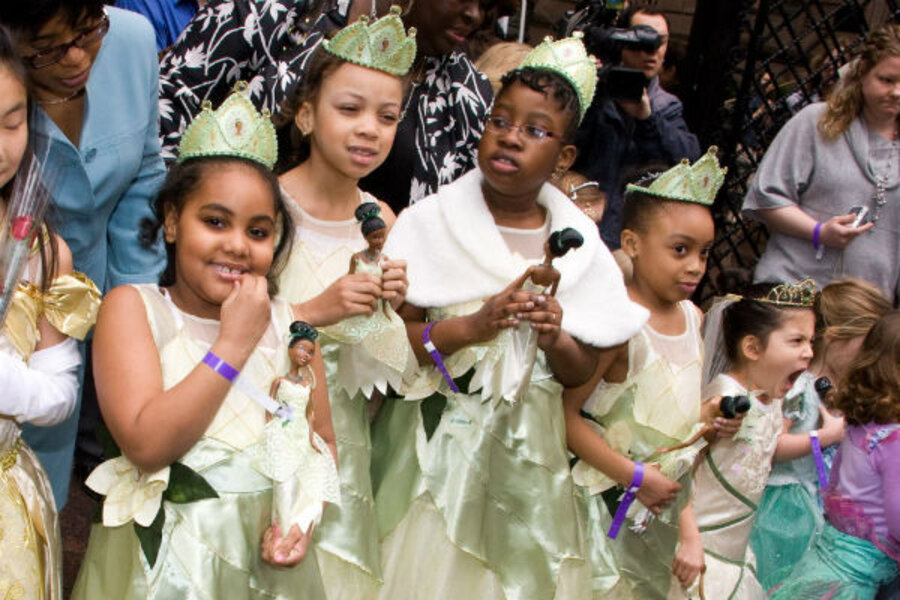Disney Princess diversity: Characters changed via Tumblr, D-Tech
Loading...
A couple of weeks ago, a young woman named Lauren reimagined the white Disney Princess characters as women of color, posting recolored images of them on her Tumblr blog. Her inspired designs quickly made their way around the blogosphere.
Responses ranged from supportive (“I love this!“) to perplexed (“This was done because…?"); from grateful to critical (including requests for more inclusivity); and, sadly, from defensive to exclusionary (people of color “should come up with their own princesses and heroes“) and clearly racist.
I wrote a little about the Disney Princess franchise and race earlier this year, when I noticed that in the Disney Store’s 2012 redesign of their Disney Princess dolls, Disney westernized Mulan’s dress and lightened Pocahontas’s skin. So when the Huffington Post Live asked me to be their expert guest on a segment called “Black and Brown Princesses” about the reimagined Disney Princess characters from Lauren’s Tumblr, I was happy to oblige.
Although I have my criticisms of the Disney Princess franchise in general, I do think it’s important for young girls to see characters on screen and elsewhere in popular culture that look like them. I’ve been doing academic research on the Disney Princess phenomenon for a while now, and I’ve heard about the heartbreaks caused by Disney’s predominant whiteness: The little black girl who came home from first grade in tears because her classmates said she couldn’t be a princess. Their reason? She wasn’t white. (This was pre-Tiana.) The little Latina girl who would brush and brush her tightly curled hair, completely frustrated that she couldn’t smooth it out so that she would look more like a princess. (New princess Merida is the only one without silky smooth straight hair.)
While conducting field research for my book, "Growing Up With Girl Power," I also saw firsthand how important diversity in dolls and other products is to pre-adolescent African-American girls. For example, the racial diversity of Bratz dolls was really important to the African-American girls in my study. For them, the diversity was often much more important than the dolls’ skimpy fashions, which have resulted in a lot of negative publicity for the brand. The girls also cared tremendously about whether popular characters like Dora the Explorer and those from "The Proud Family" were represented on toys and other products with the same skin tone as they had on television. (I remember that a beach towel depicting Dora with the wrong skin tone had been a serious affront.)
As these girls and I talked and talked about how few characters looked like them, I found myself remembering being a young girl and wanting nothing more than a doll that had brown hair and brown eyes, like me. Unfortunately, in the late 1970s/early 1980s, these were almost impossible to find, as my mother can attest: She had to hunt high and low to find a single brown-haired doll whose eyes were brown, not blue. When I shared this memory with the girls, they were surprised. “How rude!” one said.
That’s one of the brilliant things about the “My American Girl” dolls. Although they are prohibitively expensive for most families (sigh), girls can customize the dolls to have whatever skin tones and hair colors they’d like – just like Lauren did with the Disney Princess images on her Tumblr blog. Of course, there’s little diversity in actual facial features, which is an ongoing problem in the doll business. Even when racially and ethnically diverse dolls are available, their facial characteristics typically reflect white beauty norms. In the essay “Dyes and Dolls: Multicultural Barbie and the Merchandizing of Difference,” scholar Ann duCille famously criticized such dolls for being merely “dye-dipped” – brown versions of their white counterparts.
In this context, a new experiment from Disney is fascinating. As of this week, children ages 3 to 12 who are visiting Walt Disney World’s Downtown Disney Marketplace may order custom-modeled 7-inch Disney Princess figurines made to look like them. Just like them. As in modeled after images taken via 3D scans of the children’s own faces. (Some reports have stated this service is available at Disneyland, but a Disney rep on the Disney Parks web site has clarified that the D-Tech Princesses are only going to be available in Walt Disney World in the Downtown Disney Marketplace.)
The price is about the same as an American Girl doll, but thanks to the 3D technology, these new “D-Tech Me” princess figurines won’t just have the children’s eye and hair color, they’ll also have their noses, cheekbones, lips.
The service is being offered for a limited time, and the characters available are Ariel, Aurora, Belle, Cinderella, Rapunzel, Snow White, and Tiana. (Sorry, Mulan, Pocahontas, Jasmine, and Merida!)
I have to agree with the Business Insider that the samples images Disney has shared so far look pretty creepy – a little too “uncanny valley” for my taste. And I’m not sure why three of the four characters of color from the Disney Princess franchise are being excluded as choices in the first place; it seems a little insensitive. (Anyone have thoughts on that?) But I don’t agree with Marketplace that the figurines are a sign of the apocalypse.
Although the Disney Princess franchise teems with stereotypes about girlhood, femininity, physical appearance, and race (and although I strongly dislike that the girls’ heads will be as large or larger than their waists on these figurines) the reality is this: Little girls are growing up in a princess-obsessed girls’ culture, and feeling excluded hurts.
By letting any girl see herself as a princess – well, at least any 3- to 12-year-old girl whose parents can bring her to Disney World and afford to pay $99.95 plus shipping and handling for a figurine – Disney has taken another small step in the right direction. I’ll be curious to see whether the experiment catches on.
The Christian Science Monitor has assembled a diverse group of the best family and parenting bloggers out there. Our contributing and guest bloggers are not employed or directed by the Monitor, and the views expressed are the bloggers' own, as is responsibility for the content of their blogs. Rebecca Hains blogs at rebeccahains.wordpress.com.








